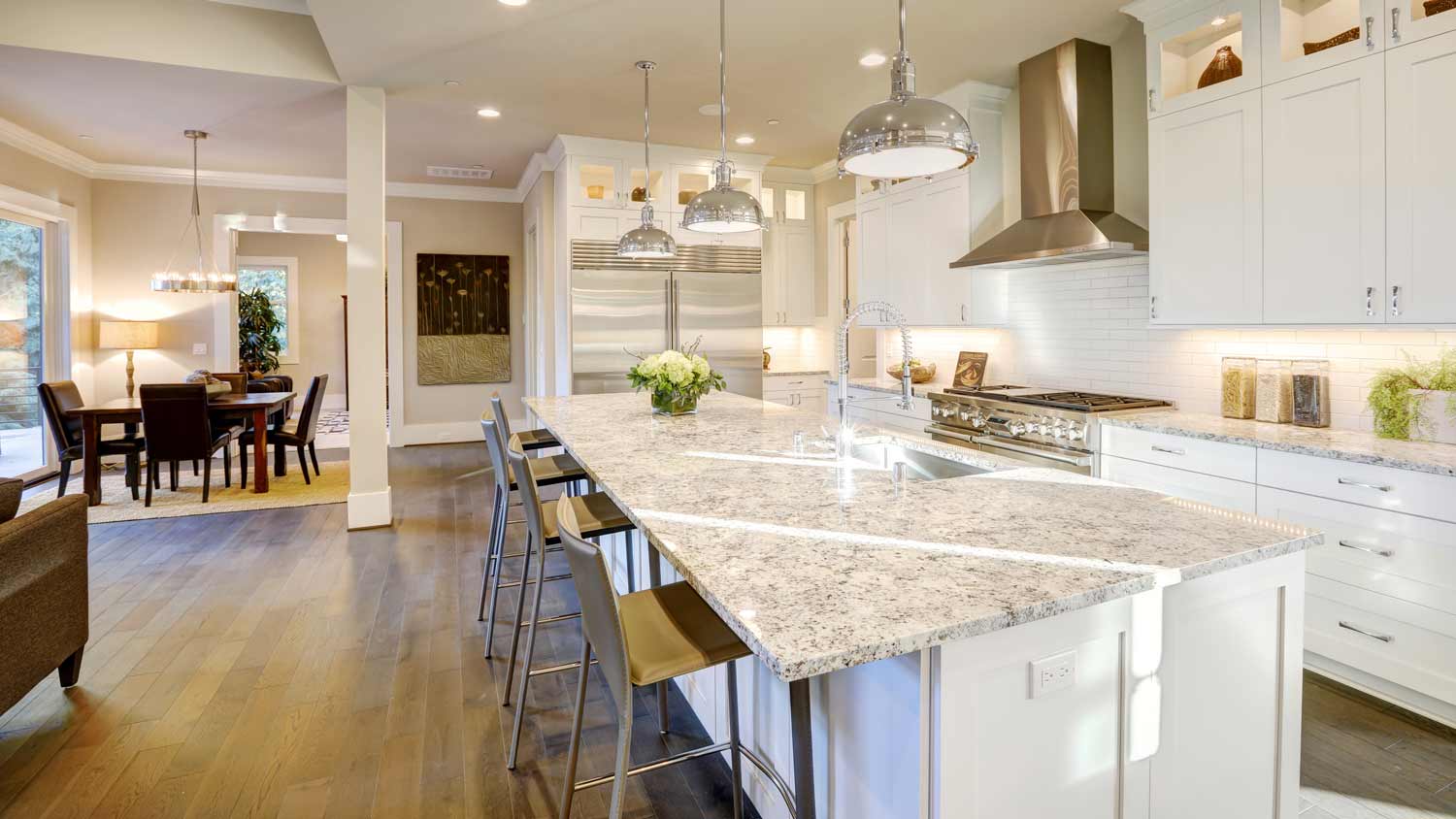
Add a wow factor to your home with a chandelier. Chandelier installation costs depend on style, location, and labor, so learn what you can expect to budget.
We’re shining a light on the differences between these fixtures


Chandeliers have multiple branches hung by more than one chain.
Pendants have one cord or chain that connects the single bulb fixture to the ceiling.
Chandeliers are best suited for large rooms that need a decorative focal point.
Pendants are best suited for lighting specific areas.
When it comes to choosing a ceiling light for your home, pendants and chandeliers are popular choices for homeowners who want to up their interior design. While both are excellent illuminators, they do come with their fair share of differences. From the way they light up a room to their design details, each fixture is best for certain spaces and aesthetics. Use this guide to determine which one is best for you.
While a pendant and a chandelier are both suspended ceiling lights, they have some key differences that make them distinct. Here’s a side-by-side look at their differences:
| Feature | Pendant | Chandelier |
|---|---|---|
| Suspension | Single cord or chain | Multiple chains |
| Lighting type | Task or decorative | Ambient |
| Appearance | Simple design with one bulb | Intricate design with multiple bulbs |
| Materials | Wide range of materials used | Smaller range of heavy, higher-cost materials |
| Cost | $15 – $4,500 | $100 – $4,500 |

The most notable difference between pendants and chandeliers is the way they’re suspended from the ceiling. Chandeliers use multiple chains to support the heavy weight of their branching design. Each branch is often connected to its own chain. Pendants, on the other hand, are typically suspended by a single cord or chain.
Chandeliers and pendants each give off a different type of lighting. Chandeliers provide ambient lighting for overall illumination in a room. Chandelier lighting is indirect and often paired with other light sources.
Pendants provide task or decorative lighting to your space. Depending on where they’re placed, they can help illuminate certain spaces such as a desk, kitchen counter, or a bed. They give direct light to the area where they’re installed.
Chandeliers are often much more intricate than pendants. They usually have multiple light bulbs held by multiple branches. They’re also great as focal points for a room and act as decoration in a lot of interior designs. Due to their grandiose nature, they’re an ideal addition to dining rooms and great rooms.
Pendants have a much simpler design. They only have one bulb in the fixture and use a single rod or chain to connect to the light source. There are different pendant styles available that are more ornate and decorative, but typically pendants will have a sleek, simple design.

Chandeliers are made from just a few heavy materials that require a sturdy chain to suspend them, including:
Bronze
Glass
Steel
Crystal
Wrought iron
Pendants are crafted from a wider variety of materials including:
Tiffany glass
Blown glass
Bronze
Nickel
Brushed steel
Fabric
Chandeliers tend to be more pricey than pendant lights. They use more expensive materials, are larger in size, and require a more extensive installation. Chandeliers range in price from $100 to $4,500 and their installation cost ranges from $300 to $2,000.
Pendants are usually at a lower price point than chandeliers since they’re more simple in design and use lower-cost materials. The installation process for a pendant light is often much simpler as well, resulting in lower labor costs. The cost of a pendant light ranges from $15 to $4,500 and their installation cost ranges from $50 to $300.
Choosing the fixture that’s best for your home depends on the space you’re planning to illuminate and the appearance you’re looking for. If you want to brighten up a large room and add a decorative touch, a chandelier is a great option. If you’re trying to add more light to a kitchen island or workspace to help with tasks, a pendant light might be the way to go.
No matter the light fixture you choose, it’s always recommended to contact a local light fixture technician near you to complete the installation. The hourly rate for hiring a pro ranges from $50 to $100 per hour. Working with electricity can be a dangerous task, and they have the knowledge and skills to stay safe. They’ll be able to answer any questions you may have, install the fixture, and make sure everything is working correctly.
From average costs to expert advice, get all the answers you need to get your job done.

Add a wow factor to your home with a chandelier. Chandelier installation costs depend on style, location, and labor, so learn what you can expect to budget.

Discover the cost to install recessed lighting. Discover how price factors, labor, and other considerations can help you save on your lighting project.

Discover the professional Christmas light installation cost, including average prices, cost factors, and tips to save on your holiday lighting project.

You don’t always need a pro for recessed lighting fixes. Learn how to change a recessed light bulb on your own for an easy, affordable home repair.

Learn how much a light costs a year, so you can learn how to calculate the annual price for light fixtures and decide on the right bulbs for your home.

Life happens, and bulbs break! Learn how to remove a broken light bulb the safe, easy way with five proven methods in this guide.